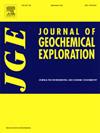OreGenes: An optimized neural network tool for ore deposits classification based on gold grain geochemistry
IF 3.4
2区 地球科学
Q1 GEOCHEMISTRY & GEOPHYSICS
引用次数: 0
Abstract
Assessment of gold grains and their characterization in abundance and morphology can be used as a discriminatory tool for mineral deposits. However, the processes that lead to the formation of an ore deposit are multiscale and nonlinear. As a result, the elemental compositions recorded in gold grains during mineralization seem mostly irregular and unpredictable. Here, we took advantage of the capabilities of neural networks, computational models composed of layers of interconnected nodes. After training, it processed data through nonlinear transformations that approximate a complex natural function. It enabled the recognition of complex patterns and relationships in chemical variability observed in gold and relating it to the mineral system that formed the mineral, allowing for predictive modeling. This was achieved by using published trace element data in gold of four types of gold deposits (i.e., Orogenic, VMS, porphyry, and epithermal) from 47 different localities, obtained by laser ablation-inductively coupled plasma-mass spectrometry (LA- ICP-MS). The model was optimized by training five different architectures on the most influential elements, determined by principal component analysis (PCA). As a result, two hidden layers with ten neurons (series of nodes that process and transmit information) each were found to be the best architecture for using trace elements as predictors of the type of deposit that formed a natural gold grain. In order to encourage the use of the findings made in this paper, we introduce OreGenes, an app developed in Matlab2023b based on the best-obtained model. It allows any user who possesses compatible data the ability to import and process it to obtain a prediction with an average accuracy level of 88.9 % confidence to assess the mineral deposit type that an unknown gold grain came from, which grants the user the ability to have a powerful tool for exploration or research.
求助全文
约1分钟内获得全文
求助全文
来源期刊

Journal of Geochemical Exploration
地学-地球化学与地球物理
CiteScore
7.40
自引率
7.70%
发文量
148
审稿时长
8.1 months
期刊介绍:
Journal of Geochemical Exploration is mostly dedicated to publication of original studies in exploration and environmental geochemistry and related topics.
Contributions considered of prevalent interest for the journal include researches based on the application of innovative methods to:
define the genesis and the evolution of mineral deposits including transfer of elements in large-scale mineralized areas.
analyze complex systems at the boundaries between bio-geochemistry, metal transport and mineral accumulation.
evaluate effects of historical mining activities on the surface environment.
trace pollutant sources and define their fate and transport models in the near-surface and surface environments involving solid, fluid and aerial matrices.
assess and quantify natural and technogenic radioactivity in the environment.
determine geochemical anomalies and set baseline reference values using compositional data analysis, multivariate statistics and geo-spatial analysis.
assess the impacts of anthropogenic contamination on ecosystems and human health at local and regional scale to prioritize and classify risks through deterministic and stochastic approaches.
Papers dedicated to the presentation of newly developed methods in analytical geochemistry to be applied in the field or in laboratory are also within the topics of interest for the journal.
 求助内容:
求助内容: 应助结果提醒方式:
应助结果提醒方式:


